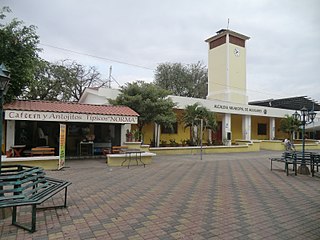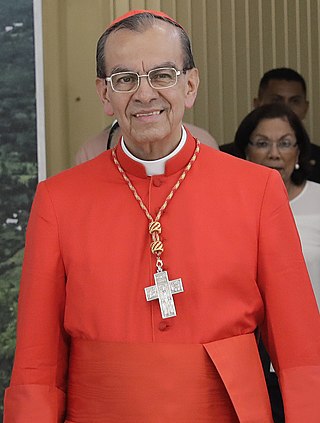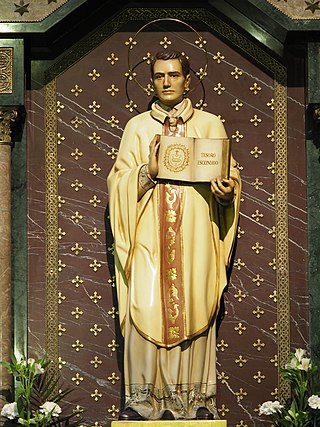Related Research Articles

Óscar Arnulfo Romero y Galdámez was a prelate of the Catholic Church in El Salvador. He served as Auxiliary Bishop of the Archdiocese of San Salvador, the Titular Bishop of Tambeae, as Bishop of Santiago de María, and finally as the fourth Archbishop of San Salvador. As archbishop, Romero spoke out against social injustice and violence amid the escalating conflict between the military government and left-wing insurgents that led to the Salvadoran Civil War. In 1980, Romero was shot by an assassin while celebrating Mass. Though no one was ever convicted for the crime, investigations by the UN-created Truth Commission for El Salvador concluded that Major Roberto D'Aubuisson, a death squad leader and later founder of the right-wing Nationalist Republican Alliance (ARENA) political party, had ordered the killing.

Aguilares is a municipality in the San Salvador department of El Salvador, located 33 km away from the city of San Salvador. The municipality measures 33.72 km² and as of 2006, had an estimated population of 73,300. Sugar cane cultivation is the major economic activity for the area.

Rutilio Grande García, SJ was a Jesuit priest in El Salvador. He was assassinated in 1977, along with two other Salvadorans. He was the first priest assassinated before the Salvadoran Civil War started and a close friend of Archbishop Óscar Romero. After his death, Romero changed his silence and urged the military junta to investigate the murder. His beatification, through his status as a martyr, was approved by Pope Francis on 21 February 2020, with the ceremony being held on 22 January 2022.

The Catholic Church in El Salvador is part of the worldwide Catholic Church, under the spiritual leadership of the Pope in Rome and the Episcopal Conference of El Salvador. There are almost 5 million Catholics in El Salvador. The country is divided into eight dioceses including one archdiocese, San Salvador. The Constitution explicitly recognizes the Catholic Church and it has legal status.

Luis Chávez y González (1901–1987) was the seventh Bishop and third Archbishop of San Salvador, El Salvador, and immediate predecessor of Archbishop Óscar Romero. Unlike Romero, who served for three years before being assassinated in 1980, Chávez had an archbishopric that was long and low key. Chávez was Archbishop of San Salvador for 38 years (1938–1977), longer than any other Salvadoran bishop. Like his more famous successor, Chávez is also a candidate for sainthood. His beatification process was started in June 2001.
Arturo Rivera y Damas was the ninth Bishop and fifth Archbishop of San Salvador, El Salvador. Msgr. Rivera's term as archbishop (1983–1994) coincided with the Salvadoran Civil War. He was the immediate successor of Archbishop Óscar Romero. During Romero's archbishopric (1977–1980), Rivera was Romero's key ally. He had been the auxiliary of Romero's long-reigning predecessor, Luis Chávez y González (1938–1977). He was also a friend of Mother Teresa, who stayed at his family home on her visit to El Salvador

The Archdiocese of San Salvador is a Latin Church ecclesiastical territory or archdiocese of the Catholic Church in El Salvador. Its archepiscopal see is the Salvadoran capital, San Salvador, and the surrounding region.

Gregorio Rosa Chávez is a Salvadoran Latin Catholic prelate who was an Auxiliary Bishop of San Salvador from 1982 to 2022. He was a close collaborator of the slain Archbishop Saint Óscar Romero.

Bernardo Francisco de Hoyos de Seña, SJ, best known simply as Bernardo de Hoyos, was a Spanish Catholic priest, mystic and member of the Society of Jesus. He is best known for his ardent devotion to the Sacred Heart and for his constant promotion of it until his premature death.

Cosma Spessotto, OFM was an Italian Catholic priest of the Order of Friars Minor. He was sent to serve in the foreign missions in El Salvador in 1950, where he aided the faithful through evangelization and the construction of churches.
Serafino Morazzone was an Italian Roman Catholic priest. Morazzone served as a simple parish priest in Lecco from his ordination as a priest in 1773 until his death and became noted amongst the faithful for his personal holiness and dedication to the sacraments.

The Martyrs of Natal were a group of 30 Roman Catholic people of Colonial Brazil – two of them priests – killed in the northern part of the colony in massacres that a large group of Dutch Calvinists led. One priest was a Colonial Brazilian Jesuit missionary, while the other priest was an evangelizer himself. The others were all lay Catholics, most of them anonymous members of the Church, some of them children.

The Martyrs of Albania were a collective group of 38 individuals killed during the Communist regime in Albania from 1945 until 1974. All were born at various times between 1874 and 1935; the group included Albanians and Italians as well as one German. Each of these individuals, apart from four, were part of the religious life as either priests or religious and served as either missionaries or educators with a great deal spending their educational formation in Italian and Austrian cities.

Arsenio da Trigolo, OFM Cap., was an Italian Catholic priest and a professed member from the Order of Friars Minor Capuchin.

Tiburcio Arnaiz Muñoz was a Spanish Roman Catholic priest and a professed member of the Jesuits. He was also the co-founder of the Missionaries of the Rural Parishes (1922) and decided to establish it to further his own pastoral goals of aiding the poor with a particular emphasis on workers and people living in those rural areas across the nation. His ecclesial career was spent in two parishes for just over a decade, before he entered the Jesuit novitiate. He became known for his tender care of all people.
Victor Emilio Moscoso y Cárdenas was an Ecuadorian Roman Catholic priest and professed member from the Jesuits. He served as a teacher in the COPEM college in Riobamba since 1892 and it was there that he was slain during the Liberal Revolution which had started in 1895. Moscoso was a noted philosopher and taught rhetoric and grammar to his students while serving as a professor; he also served as the college's rector from 1893 until his assassination.
Ángel Riesco Carbajo was a Spanish Roman Catholic prelate who served as a bishop in the Pamplona archdiocese and was the founder of the Misioneras Apostólicas de la Caridad. Riesco spent some time in Argentina as an emigrant before he returned to his homeland for a scholarship that saw his ecclesial studies spent in Madrid and Santander. He served as a parish priest following his ordination and in 1957 in Astorga founded a religious congregation dedicated to women. Months later he became a bishop but retired a decade later due to poor health that he later died from not long after.
Manuel Solórzano was a Salvadoran Catholic who was an active participant in his local parish and was close with its priest, Rutilio Grande García. He was slain alongside Grande and the teenager Nelson Lemus in 1977 on a dirt road after he tried to shield both men when armed Salvadoran soldiers killed them.

Pedro Ortiz de Zárate was an Argentine Catholic priest and Giovanni Antonio Solinas, SJ was an Italian Catholic priest in the Society of Jesus.
References
- 1 2 3 "Blessed Nelson Rutilio Lemus Chávez". Catholic Saints. 12 October 2021. Retrieved 21 January 2022.
- 1 2 3 "Beato Nelson Rutilio Lemus". Santi e Beati. 21 January 2022.
- 1 2 3 4 5 Jacqueline Villeda (18 January 2022). "¿Quién era Nelson Lemus, el joven que será beatificado junto al padre Rutilio Grande?". El Mundo . Retrieved 21 January 2022.
- 1 2 "Nelson and Manuel, Companion Martyrs". Super Martyrio. 6 November 2015. Retrieved 21 January 2022.
- 1 2 "REPORT ON THE SITUATION OF HUMAN RIGHTS IN EL SALVADOR – CHAPTER II". Inter-American Commission on Human Rights (O.A.S.). 17 November 1978. Retrieved 21 January 2022.
- 1 2 3 4 "Rutilio Grande García e 2 Compagni". Congregation for the Causes of Saints . Retrieved 21 January 2022.